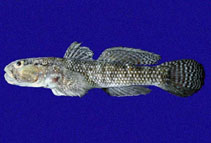| Family: |
Gobiidae (Gobies), subfamily: Gobiinae |
| Max. size: |
20 cm TL (male/unsexed); 9.5 cm TL (female) |
| Environment: |
reef-associated; marine |
| Distribution: |
Eastern Pacific: Bahía Magdalena and the Gulf of California in Mexico to northern Peru. |
| Diagnosis: |
Body small; tip of tongue bifurcated; two dorsal fins, the first with 7 flexible spines; scales large and readily visible; tips of uppermost 3 to 5 pectoral rays free; body olive green to brown; flanks with dark spots and/or diffuse (Ref. 55763); pectoral free rays, typically the first and invariably the remaining four, branched at least twice; first dorsal fin distinctly pigmented to distal edge; postorbital dark blotches on oculoscapular groove large, elongate medially; pelvic disc more or less rounded, with large lateral lobes, sometimes attenuate, and disc length about two-thirds to four-fifths abdomen; pectoral rays 19-20 (18-21); scales in lateral series 34-36 (32-38) (Ref. 87607). |
| Biology: |
Inhabits high, sandy-bottom tide pools along rocky coasts (Ref. 5592). Maximum length for female (Ref. 87607). |
| IUCN Red List Status: |
Least Concern (LC); Date assessed: 21 May 2007 Ref. (130435)
|
| Threat to humans: |
harmless |
Source and more info: www.fishbase.org. For personal, classroom, and other internal use only. Not for publication.

